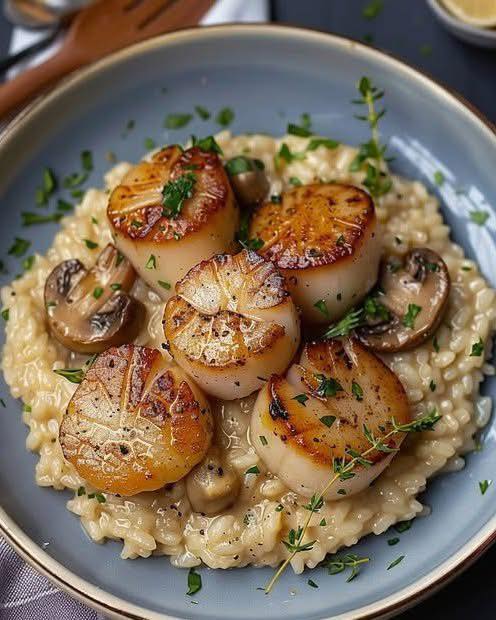Perfect Seared Scallops Over Creamy Mushroom Risotto: A Restaurant-Quality Meal at Home
Perfect seared scallops over creamy mushroom risotto bring restaurant elegance to your dinner table with surprisingly simple techniques. This dish combines the delicate sweetness of fresh scallops with the earthy richness of mushrooms and the comforting creaminess of perfectly cooked risotto. When you master this recipe, you will impress guests and treat yourself to gourmet dining at home.
The key to perfect seared scallops lies in achieving that golden-brown crust while keeping the interior tender and moist. Meanwhile, the creamy mushroom risotto requires patience and attention to develop its signature velvety texture. Together, these elements create a balanced dish that showcases both seafood and seasonal produce at their best.
Quick Recipe Highlights
- Flavor Profile: The dish balances sweet scallops with earthy mushrooms and rich, savory risotto. A touch of white wine adds acidity to cut through the creaminess.
- Texture: Crisp seared scallop exteriors contrast with their soft centers, while the risotto offers a luxurious, slightly al dente bite.
- Aroma: Garlic, shallots, and fresh herbs perfume the kitchen as the dish comes together, promising complex flavors.
- Visual Appeal: Golden-brown scallops crown the creamy risotto, with mushroom pieces and fresh herbs adding color contrast.
- Skill Level Needed: While not difficult, this recipe requires multitasking and attention to timing for best results.
- Special Equipment: A heavy skillet for searing and a sturdy saucepan for risotto are essential tools.
Recipe Overview
- Difficulty Level: This recipe earns its intermediate rating due to the need for precise timing and temperature control. You must manage two cooking processes simultaneously for optimal results.
- Category: This dish works beautifully as either an impressive main course or an elegant starter for special occasions.
- Cuisine: The recipe draws from Italian risotto traditions while incorporating French searing techniques for the scallops.
- Cost: While scallops represent a splurge ingredient, mushrooms and pantry staples keep the overall cost reasonable for a special meal.
- Season: Fresh scallops and wild mushrooms make this ideal for autumn, though quality frozen scallops work year-round.
- Occasion: Serve this for date nights, anniversary dinners, or when you want to showcase your culinary skills.
Why You’ll Love This Perfect Seared Scallops Over Creamy Mushroom Risotto
The combination of textures in perfect seared scallops over creamy mushroom risotto creates an unforgettable dining experience. When you bite through the crisp exterior of properly seared scallops, the sweet, tender flesh contrasts beautifully with the rich, velvety risotto. Each component complements the other, resulting in a dish greater than the sum of its parts.
Beyond taste, this recipe offers practical benefits for home cooks. You can prepare most components in advance, reducing last-minute stress when entertaining. The risotto base welcomes variations, allowing you to adapt based on seasonal ingredients or personal preferences. Furthermore, the cooking techniques you master here apply to countless other dishes in your repertoire.
Nutritionally, this meal provides high-quality protein from the scallops along with fiber and nutrients from mushrooms and arborio rice. While indulgent, the dish avoids heavy cream, relying instead on the natural starch from rice for creaminess. You can easily adjust portion sizes to meet different dietary needs without sacrificing satisfaction.
For social gatherings, perfect seared scallops over creamy mushroom risotto makes an impressive centerpiece. The elegant presentation suggests hours of labor, though the actual hands-on time remains reasonable. Guests will appreciate the thoughtful combination of flavors and textures that demonstrate your culinary care and attention.
Cost-conscious cooks will appreciate that this restaurant-quality dish costs significantly less than dining out. By purchasing scallops in bulk when on sale and using affordable mushrooms, you create luxury dining experiences at home. The recipe scales easily for larger groups, making it perfect for holiday entertaining or dinner parties.
Historical Background and Cultural Significance
Risotto originated in northern Italy’s rice-growing regions, where short-grain arborio rice thrived in the humid climate. Farmers developed the technique of slowly adding broth to release the rice’s starches, creating the dish’s characteristic creaminess. Over time, risotto became a canvas for seasonal ingredients, with mushroom versions gaining particular popularity in autumn.
Scallops have held culinary significance across coastal cultures for centuries. French cuisine perfected the searing technique that creates the signature crust while preserving the delicate interior. Combining these two elements represents a modern interpretation that bridges Italian and French culinary traditions while appealing to contemporary tastes.
The evolution of this dish reflects broader trends in home cooking, where restaurant techniques become accessible to amateur chefs. As quality seafood became more widely available and risotto gained international popularity, the combination emerged as a hallmark of sophisticated home entertaining. Today, food media and cooking shows have further popularized this impressive yet achievable dish.
Regional variations abound, with coastal areas often adding local seafood while inland regions might feature different mushroom varieties. Some versions incorporate saffron for color and flavor, while others emphasize herbs like thyme or tarragon. These adaptations demonstrate the recipe’s versatility while maintaining its essential character as a celebration of simple, quality ingredients.
Ingredient Deep Dive
Sea Scallops
Sea scallops, the star of perfect seared scallops over creamy mushroom risotto, rank among the most prized mollusks in culinary circles. These bivalves develop their sweet flavor from clean ocean waters, with diver scallops representing the highest quality. Look for dry-packed scallops without added preservatives, which sear better than their wet-packed counterparts.
Nutritionally, scallops offer lean protein with significant amounts of vitamin B12 and magnesium. Their mild flavor makes them versatile, while their quick cooking time suits busy schedules. Store fresh scallops in the coldest part of your refrigerator for no more than two days, or freeze them for up to three months with excellent results.
Arborio Rice
Arborio rice, the foundation of creamy mushroom risotto, comes from Italy’s Po Valley. This short-grain variety contains more starch than long-grain rice, which releases during cooking to create risotto’s signature texture. When selecting arborio, look for plump, pearly grains without discoloration or broken pieces.
Beyond texture, arborio rice provides complex carbohydrates and small amounts of protein and fiber. Proper storage in an airtight container protects the rice from moisture and pests. While specialty markets may carry other risotto rice varieties like carnaroli or vialone nano, arborio remains the most accessible choice for home cooks.
Wild Mushrooms
Wild mushrooms contribute earthy depth to perfect seared scallops over creamy mushroom risotto. Varieties like cremini, shiitake, or oyster mushrooms each bring distinct flavors and textures to the dish. Foraged mushrooms add seasonal interest, though cultivated options ensure year-round availability and consistent quality.
Mushrooms offer nutritional benefits including B vitamins, potassium, and antioxidants. Their umami flavor enhances the overall dish without overwhelming the delicate scallops. Store fresh mushrooms in paper bags in the refrigerator, and clean them just before use to prevent sogginess. Dried mushrooms make an excellent pantry staple for impromptu risotto preparations.
Common Mistakes to Avoid
- Overcrowding the pan when searing scallops prevents proper browning and causes steaming instead of searing. Cook in batches if necessary to maintain pan temperature.
- Stirring risotto too frequently breaks the rice grains and can make the texture gluey. Instead, stir occasionally and let the rice absorb the broth gradually.
- Using cold broth slows cooking and can make the risotto gummy. Keep your broth at a gentle simmer in a separate pot throughout the cooking process.
- Underseasoning results in bland risotto. Remember to season in layers, adding salt at each stage of cooking for balanced flavor.
- Overcooking scallops makes them rubbery. Remove them from heat when they still feel slightly underdone, as carryover cooking will finish them.
- Using the wrong rice variety fails to achieve proper creaminess. Only short-grain rice like arborio releases enough starch for authentic risotto texture.
- Adding all the broth at once prevents proper starch development. Incorporate the liquid gradually, allowing absorption between additions.
- Skipping the resting period for risotto results in uneven texture. Let it stand briefly off heat before serving for perfect consistency.
Essential Techniques
Proper Searing Method
Mastering the sear transforms ordinary scallops into the perfect seared scallops that crown this dish. Begin by patting the scallops thoroughly dry, as moisture prevents browning. Heat your pan until very hot before adding a thin layer of high-smoke-point oil. Place the scallops in the pan without touching each other, and resist the urge to move them until a golden crust forms.
The key indicators of proper searing include audible sizzling when the scallops hit the pan and easy release when the crust develops. If the scallops stick, they need more time to caramelize. Flip them only once, using tongs for precision. For even cooking, choose scallops of uniform size and thickness when purchasing.
Risotto Preparation
Creamy mushroom risotto requires patience and attention to detail. Start by sautéing aromatics until fragrant but not browned, then toast the rice briefly to enhance its nutty flavor. Deglaze with white wine, allowing the alcohol to cook off before adding broth. Maintain a steady simmer throughout cooking, adjusting heat as needed to prevent scorching.
The perfect risotto texture emerges when the rice grains remain slightly firm at the center while the surrounding starches create luxurious creaminess. Test for doneness by tasting a grain – it should offer gentle resistance without crunch. Finish with butter and cheese off heat for maximum silkiness, stirring vigorously to incorporate.
Pro Tips for Perfect Seared Scallops Over Creamy Mushroom Risotto
Purchase scallops labeled “dry-packed” for superior searing results, as these contain no added moisture. Ask your fishmonger for the freshest available, checking for firm texture and sweet ocean aroma.
Use homemade seafood or mushroom stock if possible, as the quality of broth dramatically affects risotto flavor. Simmer mushroom stems and trimmings with basic aromatics for an easy flavor boost.
Time your cooking so the risotto finishes just before serving. Unlike pasta, risotto doesn’t hold well, while scallops must be served immediately after cooking.
Invest in a quality heavy-bottomed pan for both searing and risotto. Even heat distribution prevents hot spots that could burn delicate ingredients.
Let scallops come to room temperature before cooking for more even searing. About 15 minutes out of refrigeration makes a noticeable difference.
Finish the dish with a squeeze of fresh lemon juice to brighten flavors. The acidity balances the richness of both scallops and risotto beautifully.
Variations and Adaptations
For seasonal variations, try perfect seared scallops over creamy mushroom risotto with spring peas and morel mushrooms in April or May. Summer versions might feature corn and chanterelles, while winter adaptations could include black truffle shavings for luxury.
Dietary modifications easily accommodate different needs. Use vegetable broth and nutritional yeast for a dairy-free vegan version, or substitute cauliflower rice for a low-carb alternative. Gluten-free cooks need make no changes, as the recipe naturally contains no gluten.
Flavor variations might include adding saffron threads to the risotto for color and complexity, or incorporating crispy pancetta for smoky depth. Fresh herbs like tarragon or thyme can change the profile dramatically with minimal effort.
Presentation alternatives include serving the risotto in wide, shallow bowls for elegant plating or using ring molds for restaurant-style precision. Garnish options range from simple parsley to edible flowers for special occasions.
Serving and Presentation Guide
Plate perfect seared scallops over creamy mushroom risotto immediately after cooking for optimal texture and temperature. Use warm plates to prevent rapid cooling, and arrange the scallops slightly overlapping for visual appeal. Spoon the risotto first, creating a slight well in the center to nestle the seafood.
Garnishes should enhance without overwhelming. A light sprinkle of fresh herbs like chives or parsley adds color contrast, while a drizzle of high-quality olive oil provides sheen. For special occasions, a few delicate mushroom slices or microgreens elevate the presentation.
Traditional accompaniments might include a simple green salad with acidic dressing to cut the richness. Modern interpretations could feature roasted vegetables or a citrusy slaw for textural contrast. Consider the overall meal composition when planning side dishes.
Temperature considerations are crucial – serve immediately after plating while the scallops retain their crisp exterior and the risotto maintains its creamy texture. If serving family-style, bring components to the table separately for guests to assemble their plates.
Wine and Beverage Pairing
White wines with good acidity complement perfect seared scallops over creamy mushroom risotto beautifully. A crisp Chablis or unoaked Chardonnay cuts through the richness while highlighting the seafood’s sweetness. For more adventurous pairings, try an aromatic Gewürztraminer or dry Riesling.
Non-alcoholic alternatives might include sparkling water with citrus for cleansing the palate between bites. Herbal teas like chamomile or lemon verbena offer interesting flavor parallels without overwhelming the dish.
When considering serving temperature, chill white wines to about 50-55°F for optimal enjoyment. Warmer temperatures mute acidity, while colder ones mask flavor nuances. Pour beverages just before serving to maintain ideal conditions throughout the meal.
Storage and Shelf Life
Store leftover perfect seared scallops over creamy mushroom risotto separately for best results. Keep scallops in an airtight container in the refrigerator for up to two days, though they’re best enjoyed immediately. Risotto will thicken upon cooling but retains quality for three days when properly stored.
Reheat components gently to preserve texture. Warm risotto with added broth or water over low heat, stirring frequently. Briefly sauté leftover scallops in a hot pan to refresh the exterior. Avoid microwaving, which can make both elements rubbery.
Freezing isn’t recommended for scallops after cooking, as the texture suffers dramatically. Risotto freezes moderately well for up to one month, though it may lose some creaminess upon thawing. Reheat frozen risotto slowly with additional liquid to restore consistency.
Make Ahead Strategies
Prepare risotto components in advance to streamline cooking. Wash and slice mushrooms, measure rice, and make broth ahead of time. You can even cook the risotto about 80% done, then finish with final broth additions just before serving.
For scallops, pat them dry and season in advance, keeping them refrigerated until cooking time. Have all utensils and pans ready before starting, as both elements require attention during final preparation.
When entertaining, consider serving appetizers that don’t require last-minute attention, allowing you to focus on the main dish. Set the table completely before beginning to cook, minimizing distractions during critical cooking moments.
Scaling Instructions
Perfect seared scallops over creamy mushroom risotto scales beautifully for different group sizes. For larger gatherings, use multiple pans to avoid overcrowding scallops during searing. Increase risotto ingredients proportionally, though you may need slightly less broth per cup of rice in larger batches.
When halving the recipe, reduce broth gradually, as smaller quantities evaporate faster. Use a smaller pan for searing to maintain proper oil depth. Cooking times may decrease slightly for smaller batches, so monitor doneness closely.
Equipment adjustments become necessary when scaling significantly. A wide, shallow pan works best for searing many scallops simultaneously, while a Dutch oven accommodates larger risotto quantities better than a standard saucepan.
Nutritional Deep Dive
Perfect seared scallops over creamy mushroom risotto offers balanced nutrition when enjoyed in moderation. Scallops provide high-quality protein with minimal fat, while mushrooms contribute fiber and various micronutrients. Arborio rice offers energy-sustaining carbohydrates, though portion control helps manage calorie intake.
The dish contains significant amounts of selenium from scallops, which supports immune function, and B vitamins from mushrooms that aid metabolism. Using olive oil instead of butter for searing increases heart-healthy monounsaturated fats in the overall profile.
For weight management, focus on proper portion sizes – about 4-5 ounces of scallops and 3/4 cup risotto per serving. Increase vegetable portions if desired, adding a side salad or steamed greens to boost volume without excessive calories.
Dietary Adaptations
Gluten-free diners can enjoy perfect seared scallops over creamy mushroom risotto as written, as all ingredients naturally lack gluten. Verify broth labels if using store-bought, as some may contain wheat-based additives.
Dairy-free versions replace butter with olive oil and omit Parmesan cheese. Nutritional yeast or vegan cheese alternatives can provide similar umami depth for those avoiding animal products.
Low-carb adaptations might substitute cauliflower rice for arborio, though texture will differ significantly. Increase mushroom quantities and reduce portion sizes to lower carbohydrate content while maintaining satisfaction.
Troubleshooting Guide
If scallops stick to the pan, the surface likely wasn’t hot enough before adding them. Wait until oil shimmers and barely smokes for proper searing temperature. A well-seasoned cast iron or stainless steel pan also prevents sticking issues.
When risotto turns out too dry, stir in additional warm broth gradually until reaching desired consistency. The rice should flow slowly when spooned, not sit in a stiff mound. Conversely, overly wet risotto may need brief additional cooking to evaporate excess liquid.
For unevenly cooked scallops, ensure uniform thickness by pressing gently with your hand before cooking. If some scallops cook faster than others, rotate their positions in the pan during cooking or remove done pieces individually.
Frequently Asked Questions
Can I use frozen scallops? Yes, quality frozen scallops work well when thawed properly. Place them in the refrigerator overnight and pat very dry before cooking.
What’s the best mushroom variety for risotto? Cremini mushrooms offer reliable flavor and texture, though wild varieties like chanterelles or morels add seasonal sophistication when available.
How do I know when risotto is done? Properly cooked risotto grains should be tender with slight resistance at the center, surrounded by creamy sauce. The mixture should flow slowly when stirred.
Can I make risotto in a pressure cooker? While possible, traditional stovetop preparation yields superior texture and control. Pressure cooking risks overcooking and lacks the gradual starch development of classic risotto.
Why do my scallops release water when cooking? This usually indicates insufficient drying before cooking or the use of “wet-packed” scallops treated with preservatives. Always choose dry-packed scallops and pat them thoroughly.
How can I tell if scallops are fresh? Fresh scallops smell sweet and oceanic, not fishy. They should appear moist but not sitting in liquid, with firm, translucent flesh.
What’s the purpose of white wine in risotto? Wine adds acidity to balance richness and helps deglaze the pan, incorporating flavorful browned bits into the dish.
Can I substitute another rice variety? Authentic risotto requires short-grain rice like arborio, carnaroli, or vialone nano. Long-grain rice won’t release enough starch for proper texture.
How do I prevent risotto from becoming gluey? Avoid overcooking and excessive stirring. Remove from heat when grains are al dente, and let rest briefly before serving.
What’s the best way to reheat leftovers? Gently warm risotto with added broth on the stovetop. Briefly sauté scallops in a hot pan to refresh the sear.
Additional Resources
Expand your perfect seared scallops over creamy mushroom risotto repertoire with related recipes like saffron risotto with seafood or wild mushroom soup. Technique guides on proper seafood preparation or risotto fundamentals can further refine your skills.
For ingredient information, explore seasonal mushroom identification guides or sustainable seafood purchasing resources. Equipment recommendations might include quality cookware for consistent heat distribution, essential for both searing and risotto preparation.
Consider seasonal variations that highlight produce at its peak – asparagus in spring, tomatoes in summer, or squash in autumn. Each adaptation maintains the dish’s essential character while celebrating changing availability.
PrintPerfect Seared Scallops Over Creamy Mushroom Risotto
Description
A luxurious dish featuring perfectly seared scallops atop a rich and creamy mushroom risotto.
Ingredients
For the Crust:
- 1 lb fresh sea scallops
- 1 cup Arborio rice
- 4 cups chicken or vegetable broth
- 1 cup sliced mushrooms
- 1/2 cup grated Parmesan cheese
- 1/4 cup white wine
- 2 tbsp butter
- 2 tbsp olive oil
- 1 small onion, finely diced
- 2 cloves garlic, minced
- Salt and pepper to taste
- Fresh parsley for garnish
Instructions
1. Prepare the Crust:
- Heat the broth in a saucepan and keep warm over low heat.
- In a large skillet, melt 1 tbsp butter with 1 tbsp olive oil over medium heat. Add the onion and garlic, sauté until translucent.
- Add the mushrooms and cook until softened. Stir in the Arborio rice and toast for 1-2 minutes.
- Pour in the white wine and stir until absorbed. Begin adding the warm broth, one ladle at a time, stirring frequently until each addition is absorbed before adding the next.
- Once the rice is creamy and al dente, stir in the Parmesan cheese. Season with salt and pepper to taste. Cover and keep warm.
- Pat the scallops dry and season with salt and pepper. Heat the remaining olive oil in a separate skillet over high heat. Sear the scallops for 2-3 minutes per side until golden brown.
- Serve the scallops over the risotto, garnished with fresh parsley.
Notes
You can customize the seasonings to taste.





